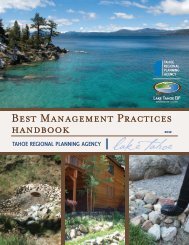4.1-d SUBSURFACE INFILTRATION SYSTEM ... - Tahoe BMP
4.1-d SUBSURFACE INFILTRATION SYSTEM ... - Tahoe BMP
4.1-d SUBSURFACE INFILTRATION SYSTEM ... - Tahoe BMP
You also want an ePaper? Increase the reach of your titles
YUMPU automatically turns print PDFs into web optimized ePapers that Google loves.
• Subsurface infiltration systems which will be load bearing shall be designed by a<br />
licensed professional civil engineer or other qualified professional to ensure<br />
structural integrity.<br />
• Subsurface installations which utilize a prefabricated product shall follow the<br />
manufacturer’s specifications for design and installation.<br />
• Consult the NRCS <strong>Tahoe</strong> Basin Soil Survey (NRCS 2007) or the <strong>BMP</strong> Calculation<br />
Spreadsheet (found at: www.tahoebmp.org) for design guidance. The <strong>BMP</strong><br />
Calculation Spreadsheet estimates potential depths to groundwater, restrictive<br />
layers, and soil permeability rates for every parcel in the Lake <strong>Tahoe</strong> Region.<br />
• On-site measurements of the Ksat are typically recommended over values<br />
estimated in the <strong>BMP</strong> Calculation Spreadsheet for designing an infiltration<br />
trench.<br />
• Depth to seasonal high groundwater, bedrock, or a restrictive layer shall be<br />
at least 1 foot below the bottom of the trench.<br />
• Pretreatment of runoff for oil and grease is necessary for large parking lots,<br />
commercial sites, and industrial sites when a significant potential exists for<br />
discharge of contaminants to groundwater or surface water (e.g. spills and high<br />
concentrations of oil/grease).<br />
• Sediment traps may be sufficient for low polluting residential and small<br />
multifamily sites.<br />
• For soils with slower Ksat rates, consider lining the bottom of the trench with 6<br />
inches to 1 foot of sand. This technique provides a layer of soil that may infiltrate<br />
better than the native soils during freezing conditions.<br />
• Avoid infiltrating water adjacent to structures when the ground slopes towards<br />
the foundation. In this instance, install a subsurface drain to convey runoff to a<br />
more appropriate location for infiltration.<br />
Subsurface Infiltration System with Pretreatment Figure<br />
Water flows through a pretreatment system to remove pollutants prior to discharging to a<br />
subsurface infiltration system.<br />
TRPA <strong>BMP</strong> Handbook<br />
May 2014<br />
CHAPTER 4: <strong>BMP</strong> Toolkit<br />
<strong>4.1</strong>-d SubSurface Infiltration System<br />
Page 29
















